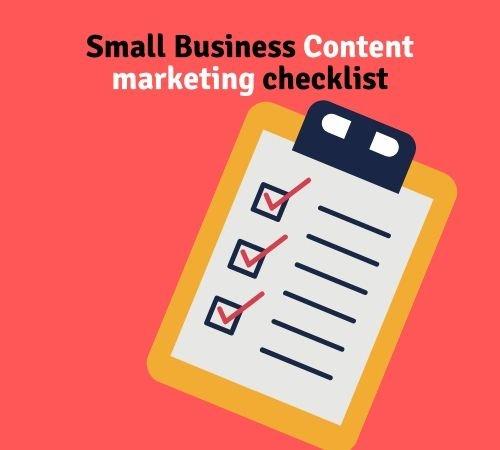Use this 8-point small business content marketing checklist to create an effective content strategy for your business.
It was Dr Gawande Atul that said “Every day there’s more and more to manage and to get right and learn” in his now-famous Checklist Manifesto: How to Get Things Right.
To the content marketer or small business owner starting out with content marketing, this quote rings so true.
Every day, you’re faced with increasing demands on your time, attention, and expertise.
Want to Grow Your Real Estate Business? Download the Complete Grant & Funding eBook for instant access to grants, guides, and more. 80+ Grant and Scholarship Opportunities (FG, State-by-State, General & Underrepresented Groups Scholarships, Plus Grant Writing Checklist). 900+ Copies Sold Already. Get Your Copy Now
There are blog titles to research; profitable keywords to uncover; demanding readers to engage; and of course, you still need to create the content, decide on distribution channels to leverage and optimize those platforms for optimal results.
It’s a hell of a legwork trying to stay on top of everything that needs to be done.
So to help you succeed; I have created this small handy checklist that will guide you in your content marketing efforts.
If you’re able to tick off on a majority of the items on the list, you’d have for yourself a solid content marketing strategy.
However, before diving into the meat of this checklist, let me first explain what content marketing is all about.
What content marketing is and what it is not.
Content marketing according to the Contenting Marketing Institute:
“is a strategic marketing approach focused on creating and distributing valuable relevant and consistent content to attract and retain a clearly-defined audience – and ultimately to drive profitable customer action.”
What content marketing is not
Content marketing is not afterthought posts or uploads on your business website without a focus or goal.
It’s not those posts you wake up and upload on your blog or social media channels.
A breakdown of the first definition provides us with the insight into all the critical moving parts that must be present to develop an effective result-getting content strategy.
The problem, however, especially for small business owners like you is that you have to juggle between several tasks.
This, of course, leaves you short on time to carry out the necessary processes required to produce high octane, customer-luring content to fuel your marketing efforts.
Moreover, most times, even when you get around to creating epic content for your business, you are stumped and confused due to the enormity of what has to be done.
Let me help you…
Need help developing a content marketing strategy for your small business?
Need help with creating valuable, relevant, and compelling content regularly for your business?
Confused about content marketing?
Let me take the hassle off your plate so you can focus on what you are good at – running your business.
The checklist below will help you keep track of everything you need for your content marketing campaigns.
Don’t create content until you answer these questions

Here are some of the essential questions to ask before creating content for your business:
Do I know who this content is for?
Asking this question pretty much kicks you to sit up and identify who your target audience is.
The question stimulates you to dig deep into understanding your target persona giving you insight into their needs.
This way, you’re able to develop content that resonates with them since you’re answering their questions, addressing their concerns and hopefully, proffering solutions to their challenges.
Understanding your target audience, is of course, the precursor to creating epic and viral content.
Other questions you can ask to gain a clearer idea of your readers include:
- What are their demographics – are you writing for mid-age career people? Or perhaps writing for free-spirited millennials?
- What’s their education level – are they college-educated? Still in college or high-school?
- What’s their income level – how much do they make in a month?
- Do they travel a lot?
- What motivates them?
- How do they behave?
- What else do you know about them?
Answering all these questions succinctly provides you with a vital tool that helps you clarify your message and ensure you hit the bull eye every time with your content marketing campaigns.
Does the content align with my business objectives?
It doesn’t make sense to produce content that is out of line with your set goals – unfortunately, in the throes of several tasks jostling for your attention – you can decide just to upload anything.
I have seen this happen over and over again with small business owners, who when questioned, answered they lacked the time, and sometimes the know-how to produce compelling copy for their business.
They simply go-ahead to post content they thought their audience would like without considering the harm it would do to their brand.
I believe as a business owner you’re in business to solve problems, right?
Awesome. So it shouldn’t be much of a hassle to align your business goals with customer needs.
Still finding it a tad challenging aligning your content strategy with your business goals?
Ok, ask these questions to clarify things:
- What are the metrics that have the most impact on my business?
- Does this content position me as an authority?
- Does this content speak to my audience?
Am I providing solutions to my readers’ challenges?
Remember, once you identify your target audience and their needs business and ensured your marketing strategies align with your business goals, it’s no longer about you nor your business.
Your focus and energy should shift to the customer.
Everything you do from this point on should be about the customer including the content you create.
One of the mind-shifting experiences I had marketing is that approaching content marketing with the customer-first mindset inspired me to produce more effective, compelling campaigns that my audience loves.
A lot of businesses are doing content marketing wrongly. They often produce salesy content where they only talk about their business and products.
A 2018 HubSpot report showed that: In general, blogs provide more content for readers to consume and share. Blog content also tends to fall under the thought leadership umbrella, whereas product-centric page content can be too self-serving to bring in non-branded searches.
This presents a great opportunity for you to dominate search engine results, build brand authority and grow revenue using effective content marketing strategies.
In the same report, HubSpot found that Inbound marketing tactics like blogging, SEO and social media bring in higher-quality leads as compared to prospected or purchased leads. In 2018, 60% of marketers saw the highest-quality leads come from inbound practices. (Source)
So, how do you ensure the content you produce is providing real solutions to your audience??
Think about your ideal customer: what problem are they trying to solve? Where are they in the buyer’s journey? Are they actively researching to learn more about the different solutions out there or are they ready to buy?
Your answers to these questions will you the insight you need to know what type of content to create and when to create them.
To create valuable content, here’s what I’d do:
- I will list out all the benefits my products/services provide.
- Outline the problems I seek to solve with my services/products
- Then, I’d create epic contents around these challenges and work my products/services as a solution.
Implementing this 3-step framework ensures that:
- The content you produce is aligned with your business objectives.
- It is targeted at your ideal customers.
- It provides real value for your readers.
- You’re positioned as a go-to person in that niche.
Create the content
At this stage, you have everything… erm… almost everything you need to produce epic viral content.
It’s time to bring all the knowledge and data together.
However, to ensure you get the best out of your content, here are essential questions to answer:
Is the content findable?
Creating content nobody sees is a waste of time and other scarce resources – which means, no leads, no authority building, and no sales.
Hence, it is crucial that every content you create for your business get found by your customers.
So, to tip the odds in your favor, ensure that your content meets the SEO best practices.
You May Like This: What is SEO?
I’m also, assuming here that you’ve already done keyword research to uncover profitable search phrases.
Other actions you can take to improve content findability include:
- Ensure the tags – H1 tags, Meta tags, alt tags, etc. – are properly placed and well optimized. These tags help the search engines to rank your content better. Also, they improve readability by breaking up blocks of text into easy-to-read bits.
- Include links to other articles on your blog to increase their visibility and help search engine crawlers find them.
For content formats such as video and audio:
- Include your keywords in the title
- Write a detailed keyword-rich summary for your content
- Distribute in different formats, especially for audio, to ensure that your customers can access them no matter what device they use.
Is the content readable?
The online reader is always scanning and skimming through articles to understand what the post is about, so make it easier for them.
To do this, you must first understand user behavior when they land on your page.
- Place important facts at the top of the content – prioritize the position of information on the page – from the most important at the top to the least important. This way, the reader gets to see the meat of the content first.
- Keep paragraphs short – large blocks of text are scary to read. Personally, I favor a three-sentence paragraph with double spacing between paragraphs.
A great example is this checklist you’re reading. Notice the spaces between paragraphs, the length of each paragraph. Aim to maintain the same formatting.
- Include bullets and numbered lists – they break up the text, presents facts in small sizable bits that can be consumed quickly.
- Can primary school pupils understand your content? Write in plain everyday language and strive to explain complex concepts using a primary school level English. No big words. Of course, I understand writing in this manner requires some level of finesse. The rule of thumb, however, is to write as you speak.
So to create understandable content regardless of your niche, tick off these items:
- Create content in the format your audience love – if your audience prefers video to text. Then, by all means, give them more video content.
- Ensure there’s context to every content produced – don’t assume your readers will “get it.” Explain even, the tiniest of details and concepts.
You can never be too sure at which point a user will jumped in on the content.
Is the content actionable?
You want your audience to take a specific action, that’s why you’re creating the content in the first place.
How do you expect them to take the desired action if you don’t tell them?
- Include a clear call to action – this informs the reader what’s the next action to take after consuming your content.
- Provide an avenue for users to leave comments and ask questions – this way you’re able to get instant feedback, glean insights into your customers’ needs, and hopefully, create content/ solutions to address them.
- List out actionable take away(s), so your audience can easily see what action to take.
Is the content shareable?
To go viral, which I suspect you want; the content must-have features that make it easy for readers to share with their friends.
Remember also, that users only share content they agree with or one that triggers an emotional response.
So, your goal should be to create content that feeds on these triggers.
- Include share buttons to ease sharing.
- Straight up ask for a share from your readers.
How do I get people to see my awesome content?

One. Word. Distribution.
To get more eyeballs on your content – you need to either post where those eyeballs are or bring them to your platform where the content is posted.
You can do both by distributing on:
Owned media platform:
- Newsletters and Emails
- Blog
- Social media – includes a Facebook business page and Group, YouTube channels, Instagram and Twitter accounts, etc.
- Email signatures
Other distribution strategies include:
- Leveraging partnerships – seek out businesses whose audience overlap with yours but not competing directly.
- Ad placement – native, PPC, paid social ad, Retargeting, etc.
- Influencer marketing
- Guest posting
Wrapping up on small business content marketing checklist
Content marketing as we all know too well has several moving parts which unfortunately can get overwhelming. The secret however to crushing your marketing goals is to stay organized.
This content marketing checklist aims to do just that – help you stay organized and ensure you’re not missing anything.

